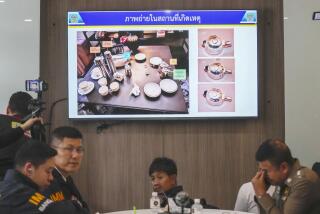Developers Plan to Put Temples of Angkor in Realm of Tourism
- Share via
ANGKOR, Cambodia — The ancient temples of Angkor have survived the ravages of nature, war and Khmer Rouge revolutionaries, standing for centuries as an isolated oasis of austere beauty.
Now, developers and some government officials want to turn it into “the greatest show on earth.”
They envision a wealth of hotels and entertainment drawing a flood of tourists and money to an impoverished Cambodia.
Conservationists are appalled. They say the area’s unspoiled nature is threatened by illegal hotel construction, uncontrolled tourism and crass shows such as a sound-and-light spectacle that reminded Co-Prime Minister Prince Norodom Ranariddh of the Disney movie “Pocahontas.”
Since the end of the civil war brought a semblance of peace to much of Cambodia, tourism has been rising and Angkor is a prime attraction. Last year, 70,000 foreigners visited Angkor, compared to 565 in 1986.
“We think Angkor has unlimited potential,” said Francis Yeoh, chief executive officer of a Malaysian company that won a development contract from local officials last year. “It is one of the areas in the world today not touched by commercial development.”
Although the numbers are still small, tourism already is taking a toll on some of the 600 Angkor monuments, some dating to the 9th century.
Plastic bags and other refuse ring the magnificent Angkor Wat, a representation in stone of the Hindu cosmos that spreads over more than 500 acres. Graffiti in Japanese, English, Thai and French is appearing, and a vulgar drawing mars one of the apsaras, the voluptuous celestial dancers that grace the temple’s immense friezes.
Seeking to protect Angkor as well as the charming nearby town of Siem Reap, one of the few vestiges of old Cambodia, the government decreed special zoning rules in 1994 to limit development in the area.
Last year, it ordered that all large hotels and other tourist facilities be confined to a 2,500-acre zone 2 1/2 to 3 miles from Angkor Wat. No hotel with more than 60 rooms was to be permitted outside the zone.
Despite the ban, Thai, Malaysian and French companies are in the early stages of building five hotels with a total of 1,295 rooms along the main approach to Angkor. Contracts for the hotels were reached with local officials after the 1994 zoning decree banning development in that area.
The International Coordinating Committee on Angkor, in which France, Japan and the United Nations play leading roles, has expressed alarm, and Cambodia’s King Norodom Sihanouk is urging that the construction be halted.
A recent visit found ground clearing in full swing at sites for the planned Royal Garden, Four Seasons Monomas, Le Meridien, Novotel and Aman Resort hotels. The deputy director of Siem Reap’s Tourist Office, Kim Chhai Hieng, said the projects would be completed in 1997.
Critics of the development say that getting around regulations is not difficult in Cambodia, where corruption is rampant.
“The power of the money people is enormous,” said Vann Mollyvann, a respected architect who heads a special government agency, APSARA, created last year to protect Siem Reap and Angkor.
APSARA says that under its charter, it must approve all hotel construction in Siem Reap but that it did not receive any documents on the five hotels. Others say it lacks the clout to stop even blatant violations.
Mollyvann says the fight over Angkor pits two opposing views; the Ministry of Tourism and businessmen seek big tourist numbers and revenue, and APSARA wants to limit visitors to minimize their impact and to plow back tourist revenue into restoration of the temples.
“We want visitors to regard it as a pilgrimage. We don’t want 20,000 tourists a day. We can’t trivialize Angkor,” Mollyvann said, stressing that Angkor was not a museum but a sacred place to Cambodians.
He described the proposed script by YTL Corp. for a sound-and-light show at Angkor Wat as “almost totally without authenticity.” After protests, including one from the king, the show is being reviewed.
The script included imagined scenes from Cambodia’s past, including one in which the king who built Angkor snatches the crown from his high priests and places it on his head.
The company had wanted to stage three shows a night at Angkor Wat for 1,500 people. It called for neon colors, music by French composer Michel Legrand and narrations by name actors.
Siem Reap’s tourism official, Kim Chhai Hieng, contends that opposition to development is a minority view.
“Only a few people are unhappy about the tourism boom. In two to three years, Siem Reap will be a very developed place. Many businessmen are coming in,” he said.
Thep Vattho, who heads the APSARA office in Siem Reap, fears that the architecture and atmosphere of one of the few places in Cambodia not greatly affected by the civil war or Khmer Rouge terror will be irrevocably degraded.
Cheaply constructed hotels have sprouted among the French colonial villas and tree-shaded streets. Some are along the river, where artisans and farmers still reside in wooden houses amid palm groves.
“We cry a lot,” she said. “Maybe one day we will have skyscrapers next to us.”
More to Read
Sign up for The Wild
We’ll help you find the best places to hike, bike and run, as well as the perfect silent spots for meditation and yoga.
You may occasionally receive promotional content from the Los Angeles Times.






